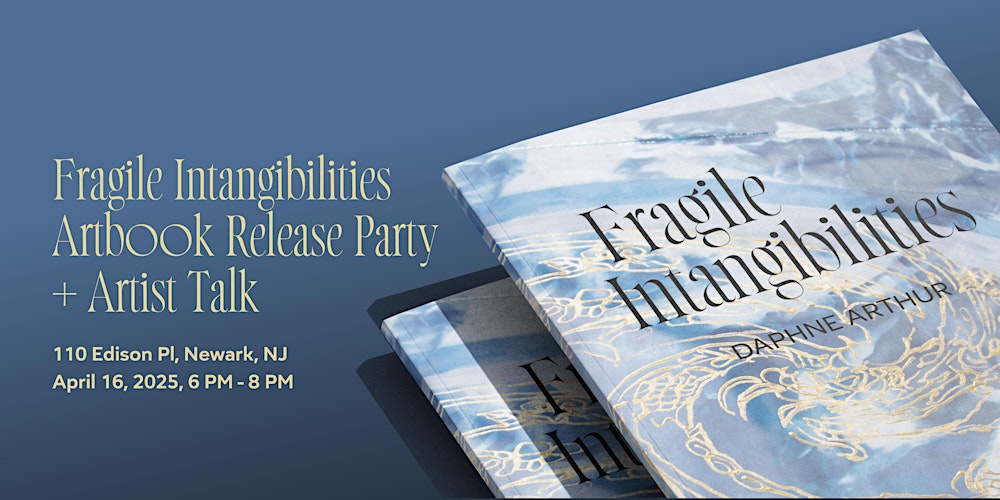|
|
Date / Time |
Cost |
Organizer |
Category |

To project and uplift the immigrants’ voices, Arthur employs refined silk fabric as an alternative skin, with each tent’s drawn-upon exterior serving as a tattoo or a sculptural codex, featuring specific, biographical, and cultural iconography. - Claudia E. Zapata
Project for Empty Space is thrilled to announce the pre-release of an editioned artist book by our Artist in Residence, Daphne Arthur. This 40-page, 6” x 9” mixed-media art book presents images from her exhibition, Fragile Intangibilities, and includes contributions from Ayokunle Falomo, Tobias Wray, and Claudia E. Zapata. The book features delicate, hand-painted silk organza layers that separate the text, beautifully mirroring the exhibition’s primary translucent material. This limited edition of 100 copies is signed by the artist.
The official book release party will take place on Wednesday, April 16, from 6–8 PM at PES Ironside (110 Edison Place, Newark, NJ). Alongside the release an artist talk will take place with fellow PES Artist in Residence, Layqa Nuna Yawar highlighting the exhibition, and their role in immigrant storytelling.
About the Contributors:
Ayokunle Falomo is Nigerian, American, and the author of Autobiomythography of (Alice James Books, 2024), AFRICANAMERICAN’T (FlowerSong Press, 2022—finalist for Texas Institute of Letters' Helen C. Smith Memorial Award for Best Book of Poetry), two self-published collections and African, American (New Delta Review, 2019; selected by Selah Saterstrom as the winner of New Delta Review’s 8th annual chapbook contest). A recipient of fellowships from Vermont Studio Center, MacDowell, and the University of Michigan’s Helen Zell Writers’ Program, where he obtained his MFA in Creative Writing—Poetry, his work has been anthologized and widely published. afalomo.com
Claudia E. Zapata (they/them) earned their PhD in art history at Southern Methodist University's RASC/a: Rhetorics of Art, Space, and Culture program. They received their BA and MA in art history from the University of Texas at Austin, specializing in Maya art (250–900 CE). From 2010-2014, Zapata was the curator of exhibitions and programs at the Mexic-Arte Museum. They held the position of curatorial assistant of Latinx art at the Smithsonian American Art Museum from 2018–2022. Currently, they are the Blanton Museum of Art's first associate curator of Latino art. claudiaelisazapata.com
Tobias Wray’s No Doubt I Will Return a Different Man won the Lighthouse Poetry Series Competition. His work has found homes in Poem-a-Day, Poetry Daily, Impossible Archetype, Blackbird, and The Georgia Review. Poems also appear in Queer Nature: A Poetry Anthology (Autumn House Press) and Poetry Is Bread (Nirala Press). Most recently, he was awarded a National Endowment of the Arts fellowship in support of new projects, including a manuscript on grief called Daddy Essay. tobiaswray.com
Layqa Nuna Yawar is a Newark-based muralist, painter, and multidisciplinary artist known for his large-scale public artworks celebrating immigrant narratives, cultural heritage, and social justice. His work blends vibrant colors, surreal imagery, and portraiture to amplify underrepresented voices and challenge dominant historical narratives.
A graduate of and current lecturer at Rutgers University, Layqa has created murals worldwide, collaborating with communities and institutions such as the Public Art Fund, MoMA PS1, and NYFA. Recent awards include an Artist Impact Award from the Newark Museum of Art, Monument Lab Research Residency, a Creative Catalyst Fund Fellowship by the City of Newark, an Art Changemaker Award from the Visual Arts Center of New Jersey, and a Moving Walls Fellowship by Open Society Foundations among others. His recent artwork can be found permanently installed at the new Terminal A at Newark Liberty International Airport, the new headquarters of Make the Road NY, and in cities and communities around the world. layqa.info
About the exhibition:
Fragile Intangibilities comprises 11 hand-sewn silk organza camping tents. Each tent is suffused with drawings made with ink inspired by interviews that Arthur conducted. Arthur, a Venezuelan-born immigrant, was in conversation with fellow first-generation immigrants and migrants in New York City and Connecticut.
These floating, translucent mobile homes depict the unique and personal stories as kaleidoscopic spectrums of amalgamated memories. They contain depictions of personal mythologies that families reproduce. Interrelated sequences do not merely establish human action in time, they also establish themselves in memory, which repeats and re-collects the course of events. Engaging the theme of movement and confronting these histories, the travelers’ retelling requires a return to the past to reformulate the story in the present and to bring it forward to the possibilities of the future. Continue reading here.